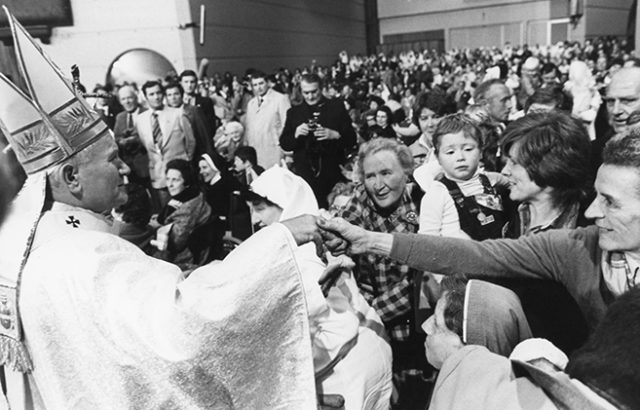By BRETT ROBINSON
It has been said that St. John Paul II was our first “media” pope. His international visits attracted scores of media attention. Television footage of millions attending a papal Mass were awe-inspiring. In 1987, the Holy Father delivered a prayer for world peace to over a billion people thanks to satellite TV. Media technology was helping to spread the Gospel message farther and wider than ever before.
Pope Francis has continued St. John Paul II’s legacy by becoming the first truly “social media” pope. His daily tweets are meant to inspire the millions of Catholics (and non-Catholics) around the world. He famously allows pilgrims to take “selfies” with him to post on Facebook and Instagram.
Each new media technology has given the church new channels for sharing the joy of the Gospel, but the story has not always gotten through.
Effective storytelling via media has long been the province of savvy advertisers. While some might sneer at ads as consumerist propaganda, it’s worth remembering that the church was first in establishing a Congregation for the Propagation of the Faith, or “Congregatio de Propaganda Fide.” A well-told story stirs the human spirit in ways that a “pope selfie” might not.
We live in an “attention economy,” meaning our most valuable and scarce commodity is attention. We have only so much of it to go around. This makes it especially tricky for institutions like the church to share messages that they think their audience needs to hear. Advertisers harness that attention by telling stories that connect with everyday hopes, fears and desires.
Simone Weil said, “Attention, taken to its highest degree, is the same thing as prayer. It presupposes faith and love.”
One current trend that has been garnering attention is the use of “content marketing” to tell stories. Rather than 30-second spots about a product, advertisers are producing elaborate minimovies about real people doing inspiring things with the company’s brand always somewhere in the background.
A good example is a 2-minute video produced by The North Face, a clothing and outdoor equipment company. The online video features climbers and skiers enduring extreme conditions and climbing to insane heights. We see the bruises, hear the screams and feel the rush.
The ad asks, “What is madness?” The answers that flash by on the screen describe the adventurers as both “obsessed and devoted,” feeling “pain” while gaining “perspective.”
Not once do we hear about a North Face product. Beyond a couple fleeting glimpses of a North Face jacket, I couldn’t tell you exactly what they are selling, because what they are selling is a feeling. At the end of the 2-minute story, you feel something, you feel different.
Consider those same bits of ad copy, “obsessed, devoted, pain, perspective,” and you also have a story of conversion. The irony here is that the church is the one with the deepest concern for our hopes, fears and desires. There is no North Face tent or fleece that is going to give us the perspective required to understand the role of pain and suffering in our lives.
How then might the church tell her story in an age of attention deficit? No amount of media attention or papal popularity can substitute for a well-told story. Perhaps there is something worth exploring in the example of the man who sits quietly between the television pope and the Twitter pope in the succession to the chair of St. Peter.
Retired Pope Benedict XVI has chosen a life of prayer and study. Or better yet, he has chosen a life of paying attention to what matters in an era that is obsessed with distraction.
While all three popes have something valuable to teach us, there may be something in Pope Benedict XVI’s approach that transcends even what the advertisers are capable of. Cardinal Robert Sarah puts it best in his book, “The Power of Silence,” by quoting Romano Guardini: “The greatest things are accomplished in silence — not in the clamor and display of superficial eventfulness, but in the deep clarity of inner vision; in the almost imperceptible start of decision, in quiet overcoming and hidden sacrifice.”
– – –
Robinson is director of communications and Catholic media studies at the University of Notre Dame McGrath Institute for Church Life.







